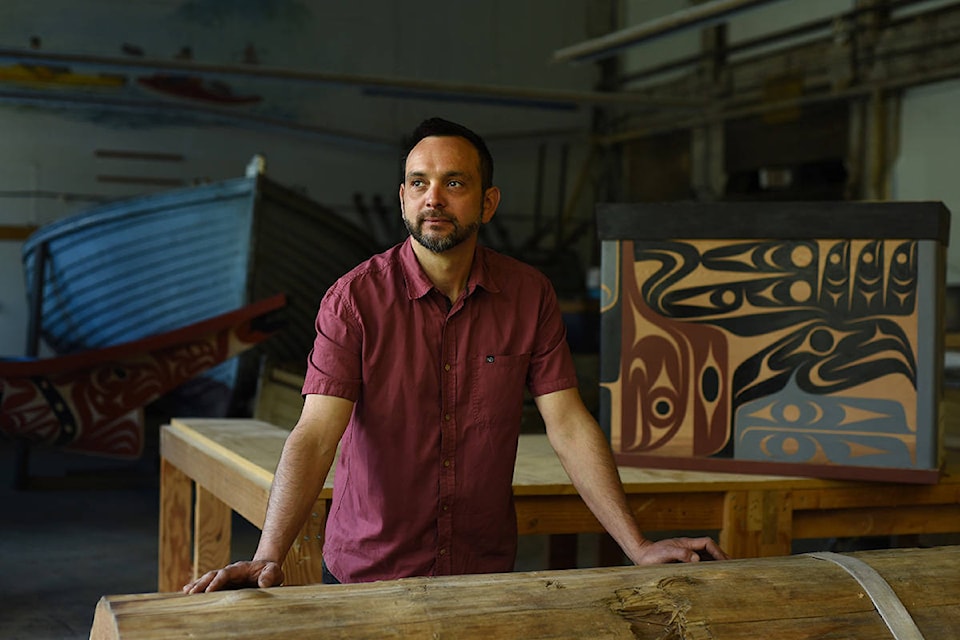-Story by Sean McIntyre
Story courtesy of Boulevard Magazine, a Black Press Media publication
Like Boulevard Magazine on Facebook and follow them on Instagram
It’s no understatement when Stz’uminus artist John Marston says he’s been living in the age of the eagle. Last year, BC Ferries announced that John’s design would adorn the side of one of the company’s new Salish-class vessels. And now, a larger-than-life eagle motif transits daily through the southern Gulf Islands.
Closer to home in Ladysmith, visitors to John’s studio are greeted by an eagle welcome statue carved from an imposing 14-foot-long piece of old-growth Vancouver Island red cedar. The carving is part of a multi-year project John and students have been working on to give the local high school a refreshing new look that acknowledges the region’s roots.
Both projects are a significant coup, not merely for John’s exemplary career as an artist, but also for the important societal shift to incorporate and recognize the significance of Vancouver Island’s rich and varied Indigenous cultures.
“To see it in the school system is really inspiring because that’s making the educators and the people that are part of these organizations aware that these are issues that we have to look at, talk about and teach our children,” he says. “That real history that hasn’t been taught, but there’s more awareness, and the artwork is one of the things that helps people open up conversations about cultural practices and what was here before first contact.”
That important conversation about cultural identity and reconciliation has been part of John’s career as an artist. At eight years of age, he was in the habit of watching and learning from his elders. He gleaned the techniques of his craft from his parents, Jane and David Marston — both accomplished carvers — as well as from Cowichan Tribes’ master carver Simon Charlie.
John soaked in the rich talent that surrounded him. As he emulated the techniques of his masters, he saw Indigenous carving take an entirely new shape around him. Duncan’s City of Totems project, for example, placed Vancouver Island’s carving heritage at the forefront of the public eye. The Indigenous traditions of Vancouver Island were experiencing a resurgence that empowered local First Nations and promoted a deeper understanding of the region’s past.
As John gained experience, his confidence grew. By the time he was a young man, John was carving alongside artists from across British Columbia at Thunderbird Park next to Victoria’s Royal BC Museum, where he spent four years, the last of which as an artist in residence.
It was soon after that formative stage that John’s work took on a much more personal tone, he says. Though firmly based in the teachings and techniques of his elders, the young carver gave his imagination free reign. Eventually, he began to experiment, leaving the old ways and branching off into new areas. Exploring. Experimenting. And learning. The result, he says, is a carving style that straddles old-world legends and modern-day spiritual expression.
“I could keep doing one-layered work until I grow old, or I can push my own abilities and carry on forward,” he says. “It’s always good to understand that there’s a modern-day movement of artists. We are artists of today who are part of old communities.”
| Artist John Marston carves a mask in his studio. Don Denton photography |
John’s creative potential is well represented by his current workspace. For the past three years, he’s been based in a 1930s-era shipping warehouse that also houses the Ladysmith Waterfront Gallery. The additional space means more of John’s works in progress can see the light of day.
During a visit to the studio earlier this spring, I found John putting the final touches on a sun mask, hewn from a piece of second-growth red cedar. Cradling the mask at his workbench while shaping it with the surgical precision of one of his finishing blades, John explains how it isn’t unusual for a piece like this to take up to four or five years to complete.
Inspiration can be fleeting. John routinely switches between pieces depending on his perspective.
“To have a consistent body of work in progress, you need to have things progressing all the time,” he says. “Every piece that I do is very well thought out and well planned out. It’s never just quickly done. Even if it’s totally different than what I normally do, I always give 100 per cent and my best ability.”
Whereas many of John’s projects were previously stashed away out of sight due to space constraints, his cavernous new space means he can have several projects on the go all at once, freely shifting between pieces depending on timelines. Alongside the sun mask and the giant eagle welcome pole, John has ceremonial cedar boxes, impressive wall hangings, abstract canvas watercolours, weavings and at least two traditional harbour-style canoes.
“I always wanted to carve canoes, so I decided to start with these,” he says. “These would have once been seen everywhere on the south coast.”
In between the works in progress are the raw materials that will fuel countless projects to come. Antlers, shells, cedar bark, kelp and raw lumber await their transformation. John collects the materials from his traditional territory in the hills and shoreline that surround Ladysmith. He can spend days out in the wild in a search that brings him closer to the natural world.
“It’s a big part of who I am as an artist. Taking the time out to collect the material and having that connection to the natural world is really important to me,” he says. “Imagination and inspiration for the work has to evolve and come from somewhere. Our culture teaches us that so much of who we are is based on the natural world. That’s where I find my inspiration.”
The works of John Marston will be exhibited at the Ladysmith Art Gallery in September.



